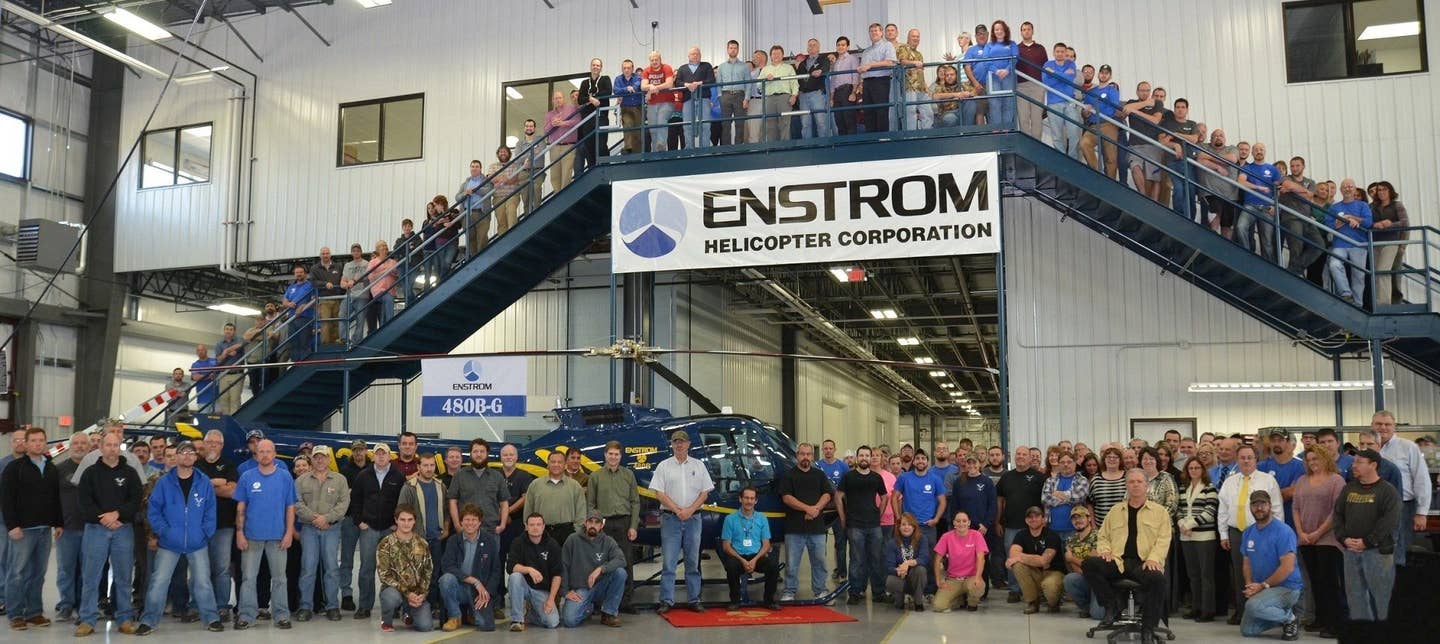Enstrom Helicopter Files for Bankruptcy After 64-Year Run
The company struggled to make money in the wake of the slumping helicopter market and the pandemic.

In all, about 30 workers lost their jobs due to the closure of Enstrom Helicopter Corp. [Courtesy: Enstrom Helicopter Corp.]
After nearly 65 years in business, Enstrom Helicopter Corp. closed its factory doors on January 21 after declaring Chapter 7 bankruptcy.
Despite building more than 1,300 helicopters that were sold to customers in more than 50 countries, the Michigan-based company announced that “several financial difficulties,” some related to the pandemic, compelled its owners to close the company.
Dennis Martin, Enstrom’s director of sales, shared the news in a letter to its suppliers and dealers in which he confirmed “all existing contracts and agreements [with the company] will become null and void.”
“Enstrom understands that you all have customers you are supporting and that this will put both you and your customers in a difficult position,” Martin said.
All employees, about 30 in total, lost their jobs, Enstrom’s president Matt Francour told the Eagle Herald.
Enstrom’s final delivery—a pair of 280FX aircraft—was to the Peruvian Air Force in December 2021. Meanwhile, Enstrom ceased its parts and overhaul supply services on January 7, before ending its technical support on January 19.
New Investment Couldn’t Outlast Waning Demand
Enstrom was acquired by Chinese firm Chongqing General Aviation Industry Group (CGAG) in December 2012. CGAG offers a bundle of other products and services, including emergency rescue, aerial forest fire protection, agricultural spray application, aerial photography, and a host of others through its subsidiaries.
The new owner tried to turn the storied brand around by investing up to $8 million to upgrade Enstrom’s factory. They nearly doubled the space, expanding it to a 160,000-square-foot FAA-approved manufacturing facility. The company also hired more than 200 new employees.
The company showed signs of tenacity when it celebrated its 60th anniversary in 2019. In an interview with Vertical Magazine at the time, CEO Matt Francour gushed over his company, sharing “how many small aircraft manufacturers have been in business for 60 years, continuously, with no bankruptcies...It’s really a testament to the people we have here, our workforce, and our local community.”
Indeed, in 2019, the company ranked third in sales of piston helicopters, with 38 sold between 2018 and 2019, but the overall rotorcraft market was in the midst of a slump. The 2019 annual report from General Aviation Manufacturers Association (GAMA) that tracks aircraft deliveries showed that 2019 was the slowest year for rotorcraft sales in the preceding seven years.
Then the pandemic hit.
GAMA’s data showed that from 2019 to 2020, the overall piston helicopter market sales and deliveries decreased by 20.7 percent.
Company History
In the 1950s, when Rudy Enstrom first had the idea of building a helicopter, he’d never even seen one before. As FLYING previously reported, the mining engineer worked on many prototypes that barely got off the ground. A local businessman, Jack Christensen, injected enough cash into the startup, and in December 1959, the R.J. Enstrom Corp. was formed.
The brand had early success. Even in 1965 when Ford introduced its legendary Mustang muscle car, it was Enstrom’s newly FAA-certified F28 that won Michigan Product of the Year.
In the 1970s, the company was building more than 100 aircraft per year. Even when the general aviation market experienced a downturn in the 1980s, Enstrom outlasted the recession to bring its 480 series turbine helicopters to market in the 1990s.
When the factory closed last week, Enstrom’s production fleet still included the turbine 480B and the piston F-28F and 280FX.
Its newest project was to be the two-seat trainer, the TH180, that it announced at the Helicopter Association International (HAI) Heli Expo in 2014. Though progress was made, the macro trend of declining helicopter sales seemed to have bested the brand.
“It’s an incredible legacy, and the people of Northern Michigan and Wisconsin who helped start the company, and especially the hard-working employees who kept it going all these years, should be proud of what we accomplished,” Martin said in his statement to suppliers.
A Second Chance?
Meanwhile, Enstrom’s leaders are optimistic about the chance at a second run. Francour said they have already fielded multiple requests from interested parties who would like to buy the company’s assets out of bankruptcy, and maybe invest in revamping the company.
In a Chapter 7 bankruptcy, the assets of a company are usually liquidated and the proceeds are used to pay off outstanding debt to creditors.
“I don’t know how, and I don’t know when, but I have a feeling [the Enstrom brand will] be back,” Francour said.

Subscribe to Our Newsletter
Get the latest FLYING stories delivered directly to your inbox






